10 transformative travel experiences that will change your life
Travel has always been a catalyst for personal development, and no form of travel is more likely to deliver it than taking a long journey. It could be an adventurous trek, rafting expedition or bike ride, a road trip to explore the history or culture of another place, or a traditional pilgrimage.
At the most straightforward level, adventures by boat, bicycle, horse or on foot offer varying degrees of challenge. Place yourself at the mercy of the Zambezi in a canoe. Trek by foot through Kyrgyzstan or by donkey in the French Cevennes.
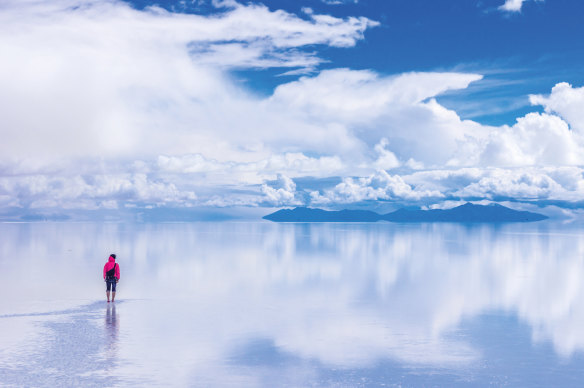
Salar de Uyuni, Bolivia. During the wet months, a thin sheet of water covers the region’s salt flats, creating a wondrous mirror-like reflection of the sky.
You may take a trip with a spiritual dimension, or perhaps a more confronting journey, exploring history and culture by, for example as featured below, tracing the Harriet Tubman Underground Railroad Byway in the US, walking with the Goolarabooloo people in Australia or discovering Warsaw’s Jewish history.
Such longer, in-depth trips are an opportunity to step outside of our daily routines. But to get the best out of meaningful travel, two more factors help: slowing down and leaving your comfort zone.
The first allows you to linger and take stock of new experiences. The second is sure to be transformative.
In this extract from the new Lonely Planet book, Your Trip Starts Here, Traveller details an array of great transformative journeys to nurture the mind, body and soul.
Experience an artistic awakening on the French Riviera, France
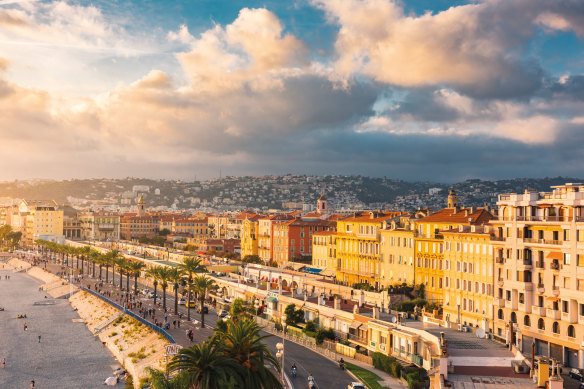
The Promenade des Anglais, Nice.Credit: Getty Images
Distance 375 kilometres
Start/finish Marseille, Nice
Mode of transport Train, bus and boat
Difficulty Easy
The lowdown Henri Matisse was bewitched by the intoxicating play of light spangling through the shutters of his hotel room in Nice. A journey along the coast, from Marseille to queen-of-the-Riviera Nice, offers a masterclass in modern art and an intimate insight into the lives of Matisse and other masters. Head for genteel Aix-en-Provence. Bronze pavement plaques trail Aix-born post-Impressionist master Paul Cezanne along elegant avenues and bijou squares. Reach jetset St-Tropez via train from Marseille to St-Raphael, then take an hour-long cruise along the coast. At sunset, seek out Paul Signac’s sublime “St-Tropez au soleil couchant” to join his glowing dots and fathom just what it was that enamoured so many artists. The train from St-Raphael to Antibes swooshes past a masterpiece of the natural kind, Corniche de l’Esterel. Stumble off in boat-bedecked Antibes, where Pablo Picasso set up studio in 1946. Explore Matisse’s phenomenal creativity at the Musee Matisse, then pay your graveside respects in the next-door cemetery. Inland, Vence is an alluring footnote to the trip.
Make it happen Direct SNCF trains (sncf.com) link Paris with Marseille in under four hours. Returning from Nice, high-speed TGVs zip to the capital in six hours. Spring and autumn are optimum times.
Ride in the hoofprints of Kyrgyz nomads, Kyrgyzstan
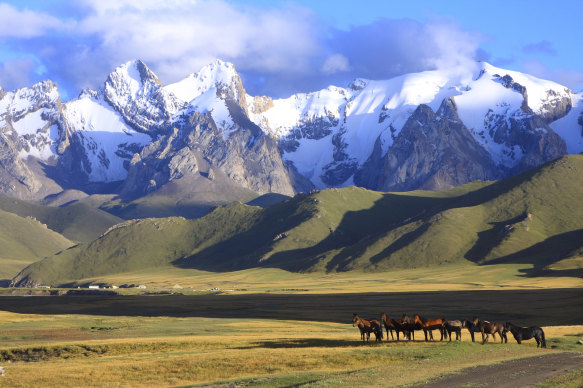
The wilds of Kyrgyzstan.Credit: Lonely Planet
Distance 400 kilometres
Start/finish Rot-Front return
Mode of transport Horse
Difficulty Difficult
The lowdown Riding is one of the more comfortable ways to get around mountainous Kyrgyzstan, where often-hazardous roads make for slow progress by car. It’s also the fastest route to immersion in the hospitable culture of nomadic Kyrgyz shepherds and the not-so-hospitable weather of the capricious Tian Shan Mountains. You may choose to ride the whole 400-kilometre loop out of Rot-Front, or just a section of it, but whether for three days or for 30, a horse-trekking journey through Kyrgyzstan is a ticket to follow in the footsteps – hoofprints – of old Silk Road traders while exploring a land where the steppe, mountains and sky meet. Approaching the dry microclimate of Konorchek Canyons, the first days are difficult. And even though the average speed on horseback is only four kilometres an hour, you’ll be surprised at how quickly the landscape changes. Each day is full of challenges, from keeping to the trail and finding grass for the horses to graze overnight to creating a sense of co-operation and teamwork between mount and rider.
Make it happen June, July and August are the best months to horse-trek in Kyrgyzstan, (discoverkyrgyzstan.org) where you’ll probably mix camping with overnights in yurts owned by Kyrgyz families. There’s no need to arrange yurt stays in advance – simply ask if you can be accommodated and be prepared to pay a modest fee.
Walk Country with the Goolarabooloo, Lurujarri Dreaming, Western Australia
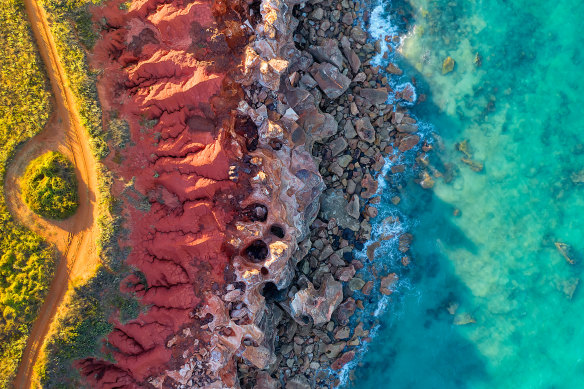
Gantheaume Point, Broome, Western Australia.Credit: Lonely Planet
Distance 82 kilometres
Start/finish Minyirr (Gantheaume Point), Minarriny (Coulomb Point)
Transport On foot
Difficulty Moderate
The lowdown This nine-day guided walk over 82 kilometres stretches north from Broome into turquoise infinity, threading along the dazzling deserted beaches, crimson-red cliffs and paperbark swamps of the remote Dampier Peninsula. Indigenous culture runs deep across the vast Kimberley region of northwestern Australia. When a Nyikina man, Paddy Roe, came to the Dampier Peninsula in the 1930s, the fading Jabirr Jabirr elders, bereft of suitable descendants, passed on custodianship of their Country (songs, stories, customs and responsibilities, inherited from the earlier Ngumbarl and Djugun people) to the young Roe. Having founded his Goolarabooloo community at Millibinyari on Ngunungurrukun, Roe instigated the Lurujarri Heritage Trail in 1987 as a means for his own people to reconnect with Country and their traditional heritage and as a way of cultivating respect for Country among non-Indigenous people. The Lurujarri Trail is a section of an ancient songline (essentially a storyline, both oral history and map), which stretches from the deserts south of Broome to the Dampier Peninsula’s northern tip. From Minyirr at Cable Beach, easy walking follows beaches, rocks and sand dunes north along the Indian Ocean coast. Luggage is transported between campsites by truck, with walkers carrying only a daypack for water, sunscreen, swimming gear and a camera.
Make it happen Broome has flight connections to and from Perth, Darwin, Sydney and Melbourne. All Lurujarri Heritage Trail walks (goolarabooloo.org.au) are fully guided. A limited number are conducted each year.
Journey France’s Robert Louis Stevenson trail with a donkey
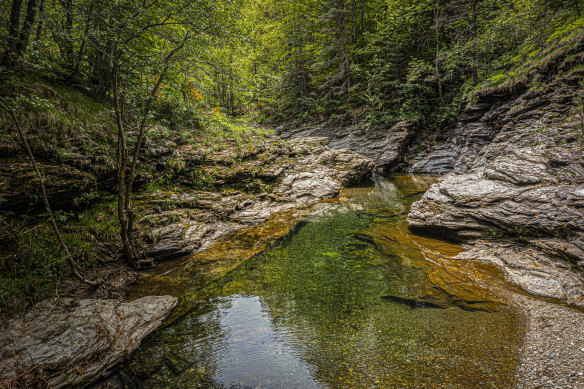
Malzac river on the Robert Louis Stevenson Trail, Cassagnas, France.Credit: iStock
Distance 272 kilometres
Start/finish Le Puy-en-Velay, Ales
Transport On foot
Difficulty Medium
The lowdown How did Scottish writer Robert Louis Stevenson do it in 1878? He didn’t have a GPS or modern hiking boots – but he did write a book about it: Travels with a Donkey in the Cevennes. The hardest part of the GR70, aka Robert Louis Stevenson Trail, is setting up a rhythm. But once both traveller and donkey have found their (hoof) beats, there seems to be no better way to explore this landscape. The first of the route’s four distinct regions, the Velay, reveals green-topped dormant volcanoes, which spread lava across the region some three million years ago. In the Gevaudan, the sound of streams and birds is predominant. Wild prairies, pine forests and pastures dotted with moss-covered rocks seem to soak up any other noise. By the time you reach the Lozere, you’ll probably have adapted your pace. At the end is the village of St-Jean-du-Gard. As Robert Louis Stevenson wrote of his donkey: “Father Adam wept when he sold her to me; after I had sold her in my turn, I was tempted to follow his example … I did not hesitate to yield to my emotion.”
Make it happen Le Puy-en-Velay SNCF station (sncf.com) has trains to/from Clermont-Ferrand and Lyon. Ales SNCF station has trains to Nimes, Marseille and Lyon. Walk the GR70 between May and October.
Trace indigenous heritage through the Canadian Rockies, Canada
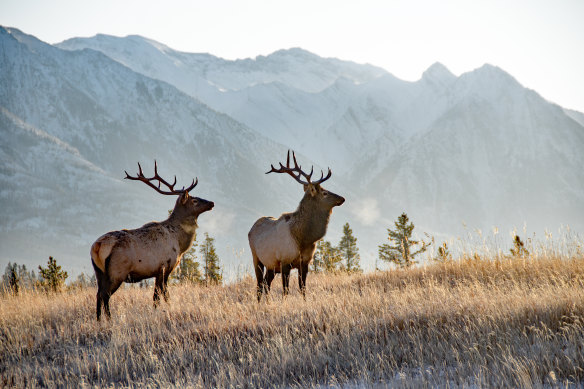
Two large bull elk in Banff National parkCredit: iStock
Distance About 1000 kilometres
Start/finish Edmonton, Banff National Park
Transport Car or bus/shuttle
Difficulty Easy
The lowdown On a road trip through Alberta in western Canada, you can learn about the traditional cultures of the Canadian Rockies. Fort Edmonton Park is a recreated pioneer village, mostly concentrated on illustrating the lives of settlers during the 19th century. But its Indigenous Peoples Experience relates a more comprehensive history: direct testimonies from the region’s Cree, Nakoda, Dene and other First Nations peoples, as well as the Metis, who have mixed indigenous and European ancestry. Today, of the more than 250,000 Indigenous people who reside in Alberta, roughly 53 per cent represent 45 different First Nations, while most of the others are Metis. About 110 kilometres northeast of Edmonton, learn more about Metis communities at the first centre dedicated to their culture, Metis Crossing. From Edmonton, travel west towards the Canadian Rockies and into Jasper National Park. Twenty-six indigenous communities have ties to the 11,000-square-kilometre park. The drive between Jasper and Banff national parks is one of Canada’s most spectacular, following the 232-kilometre Icefields Parkway. The vast Athabasca Glacier spreads across the mountains at the Parkway’s midpoint and is home to the five-kilometre indigenous-led Ice Walk. In Banff National Park, do a hike with Mahikan Trails, a First Nations-run company that introduces you to the park’s indigenous heritage, plants and animals.
Make it happen September to October, when the air begins to cool and the summer crowds abate, is particularly beautiful. Book indigenous-led tours with Jasper Tour Company (jaspertourcompany.com); Warrior Women (warriorwomen.ca); Athabasca Glacier Ice Walk (icewalks.com); Mahikan Trails (mahikan.ca).
Drive the Harriet Tubman Underground Railroad Byway, US
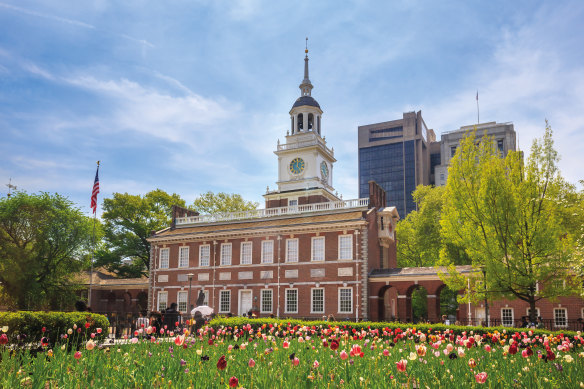
Independence Hall, Philadelphia.Credit: Shutterstock
Distance 400 kilometres
Start/finish Maryland, Pennsylvania
Transport Car
Difficulty Easy
The lowdown The Harriet Tubman Underground Railroad Byway is a 400-kilometre self-guided driving tour through Maryland, Delaware and Pennsylvania that connects 45 sites and museums related to the life and work of this freedom fighter. Though the original building burned in a fire in 1852, a courthouse in the township of Cambridge still marks the spot where enslaved people were auctioned off to the highest bidder. In 1850, one year after Tubman escaped to freedom, her niece, Kessiah, was placed before buyers. Tubman helped plan the escape of Kessiah and her family. Some 18 kilometres south, in Church Creek, stands the showpiece of the byway. Opened in 2017, the sustainably designed Harriet Tubman Underground Railroad Visitor Center has interactive exhibitions that delve into Tubman’s many rescue missions. Nearby is the Blackwater National Wildlife Refuge, which in the 19th century was a place of untold suffering for the enslaved people sent to work there. East of the Blackwater Refuge, tiny two-lane Greenbriar Road leads past the farmlands where Tubman lived her early years.
Make it happen The nearest airport to the starting point for the tour (harriettubmanbyway.org) to Cambridge is Ronald Reagan Washington International Airport. There are plenty of car hire options.
Pilot a canoe down the Zambezi River, Zimbabwe and Zambia
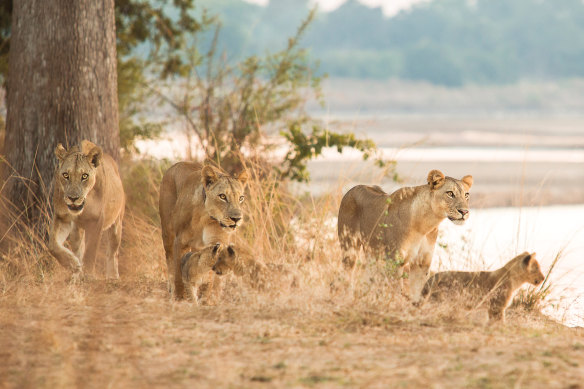
Lionesses and cubs in Zambia.Credit: Lonely Planet
Distance 70 kilometres
Start/finish Chirundu, Chongwe River
Transport Canoe
Difficulty Difficult
The lowdown Paddle your way through some of Africa’s wildest territory, steering among hippos by day and camping on remote river islands by night. Your starting point is the border town of Chirundu. You’ll soon get your bearings: to starboard (the right) is Zimbabwean territory; to port (left) the hills of Zambia. The border lies midstream, with river islands divided between the two nations. In truth, the river is its own country. You’ll soon find yourself skirting Zimbabwe’s Mana Pools National Park, said to be home to as many as the 12,000 elephants and hippos which dominate this stretch of the river. It is at once daunting – hearing the splash of a Nile crocodile slipping into the river as you paddle by – but oddly reassuring to be ensconced in your fibreglass canoe, a roving pocket of safety (as long as it remains buoyant). The day’s paddling ends with team members hauling their boats onto remote river islands and erecting a huddle of tents around a campfire before a blood-red sun slips over the horizon. But do remember – on no account should you ever get in the water.
Make it happen Lusaka’s International Airport is well served by flights from within Africa and beyond. Canoeing season on the Zambezi generally runs from March to December. River Horse Safaris (riverhorsesafaris.com) is the pre-eminent tour operator.
Follow in the ghostly footsteps of Warsaw’s heroic Jews, Poland

The POLIN Museum of the History of Polish Jews in Warsaw. Credit: Shutterstock
Distance Three kilometres gate to door - but several more depending how much you explore.
Start/finish Start: Jewish Cemetery, Nozyk Synagogue
Transport On foot
Difficulty Easy
The lowdown Beneath the cold facts of the Holocaust lie the individual stories – heroically brave and harrowingly tragic – that you can discover on a walk through Warsaw’s Muranow and Mirow neighbourhoods. Begin in Warsaw’s Jewish Cemetery where a bronze statue of Dr Janusz Korczak, the pen-name of Henryk Goldszmit, stands. He was a children’s book author and director of the city’s Jewish orphanage who sacrificed himself for his tiny charges. The death camp trains departed from Umschlagplatz. The platform is long gone, but the site is marked by a rectangular memorial symbolising the cattle wagons into which thousands of men, women and children were herded. At least 13,000 Jews fought back in the heroic but doomed Warsaw Ghetto Uprising of 1943, which led to the area’s destruction. A memorial mound, Anielewicz’s Bunker – also known as Miła 18 – stands above the hidden shelter used by Jewish resistance group ZOB. Amid many poignant landmarks, the Jewish Historical Institute (JHI), is an essential stop, as is Nozyk Synagogue.
Make it happen Jewish-themed walking tours of Warsaw are offered by Orange Umbrella Free Tour (orangeumbrella.pl, Stancja Muranow (stacjamuranow.pl), the Jewish Historical Institute (jhi.pl/en), and Taube Jewish Heritage Tours (taubejewishheritagetours.com).
Step into the infinite Salar de Uyuni, Bolivia
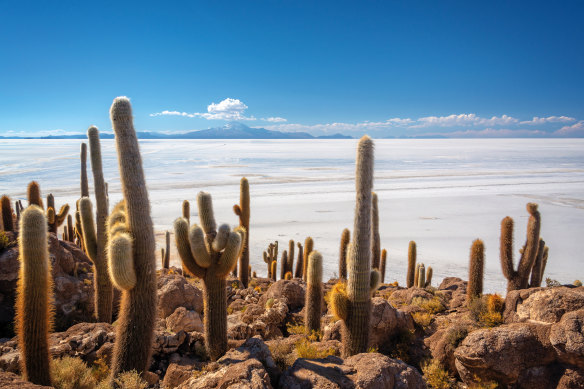
Cacti in Incahuasi island, Salar de Uyuni salt flat, Potosi, Bolivia.
Distance About 150 kilometres
Start/finish Uyuni
Transport 4WD
Difficulty Moderate to difficult
The lowdown The Salar de Uyuni are the world’s largest salt flats, covering some 12,100 square kilometres at an altitude of 3653 metres above sea level. The salt flats are an outward and inward challenge as the brisk night air will surely remind you. The morning sun glances brilliantly off the crusty, too-white surface. In the wet months, a thin sheet of water covers the flats, creating a wondrous mirror-like reflection of the sky. Tours start and finish at Uyuni. Stops might include salt-rimmed pools of underground rivers which bubble up onto the crispy surface, Ojos de Salar. At another stop, Isla Incahuasi, jagged volcanic rocks comprise leftovers of an ancient eruption which arose and then was swallowed up by a lake. Birdwatchers will be thrilled by the avian array. The Cujiri or Isla de Pescado features a cave revealing the startling strata of the surrounding desert, layer by colourful layer.
Make it happen In November, three flamingo species arrive to feast on krill in the saline lakes. During the wet months (December to April), parts of the salar, including Isla Incahuasi, are inaccessible. Red Planet (redplanet-expedition.com) is a reliable Uyuni tour operator.
Explore the Empty Quarter’s endless dunes, Oman
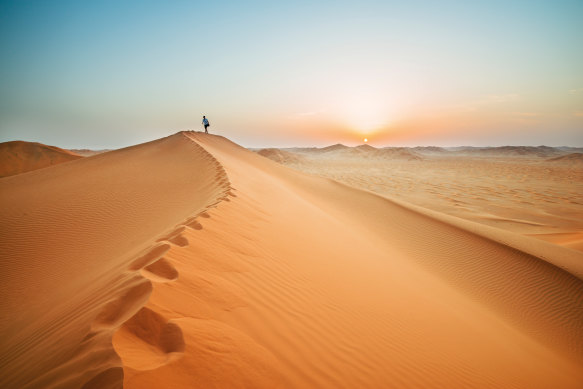
Oman’s Empty Quarter desert.Credit: Lonely Planet
Distance 300 kilometres or so one way
Start/finish Salalah
Transport 4WD
Difficulty Easy
The lowdown Known as the Rub’ al Khali in Arabic, the Empty Quarter covers some 600,000 square kilometres across Oman, Yemen, Saudi Arabia and the UAE. For hundreds of years, only Bedouin caravans ranged between its remote wells. Today, a few tourists set out on tours to nibble at the edges of the Empty Quarter but even on a short trip, you can return with a sense of its oceanic vastness. A good place to start is the port of Salalah in Oman’s greener south. Soon after leaving the city, you’ll find yourself among the frankincense groves of the Dhofar Mountains. Once a year, around June, this corner of Arabia miraculously flowers with the advent of the khareef, when the southeastern monsoon shrouds the hills. This landscape offers a last glimpse of greenery before you enter the interminable desert. The Empty Quarter is a place more or less bereft of landmarks – so four-wheel drive vehicles normally rev up the biggest dunes, make rollercoaster-like descents down sheer slopes, crest ridges and range freely across the landscape. It looks effortless but it takes immense skill. At the end of the day, the temperature cools and camp is set up as cardamom coffee boils on a fire and the wind ruffles goatskin tents.
Make it happen Connect to Salalah from Oman and airports across the Gulf. Go in the cooler months from October to April with Arabian Sand Tours (arabiansandtoursservices.com) a respected operator.
Five more journeys of self-discovery
Paddle Scotland’s Great Glen
The lochs that punctuate the Great Glen, especially Loch Ness, are deep, dark and massive. A 95-kilometre kayak of moderate difficulty, it takes three to five days. Snow Goose Mountain Centre (highland-mountain-guides.co.uk) offers fully guided trips.
Journey across India by train
Travelling from Delhi to Kerala, it’s the journey that’s definitely the destination, so plot a course right across the subcontinent to maximise your time on the rails. For a train ride with drama, it’s hard to beat the Kerala Superfast Express - a 50-hour, 3031-kilometre epic linking India’s chaotic, colourful capital and Thiruvananthapuram (Trivandrum) on the Kerala coast. See 12go.asia
Cycle the Tour Aotearoa
Riding the length of New Zealand affords the time to learn of its complex history and island culture as you pass key sites. The natural world is an ever-present companion and you’ll gain an appreciation of the vulnerability of native ecosystems and species. This trip is 3200 kilometres, from the top tip of the North Island to the bottom of the South Island. See newzealand.com
See South America by bus
You could go from Rio de Janeiro to Buenos Aires and on up the Pacific coast to Chile, Bolivia, Peru, Ecuador, Colombia and Panama and never set foot on a plane. Covering 15,000 kilometres, there is no right way to do this trip except you’ll need at least three months. Embrace the freedom to forge your own path.
Take a pilgrimage to Santiago de Compostela, Spain
Pilgrims have been making their way to Santiago de Compostela since the ninth century. Follow in their footsteps to discover Spain and yourself. This 908-kilometre walk due west from San Sebastian near the border with France is better with an openness to strangers. See spain.info
This cover story is an edited extract by Julietta Jameson of Your Trip Starts Here (Lonely Planet, $44.99). See shop.lonelyplanet.com
Sign up for the Traveller Deals newsletter
Get exclusive travel deals delivered straight to your inbox. Sign up now.